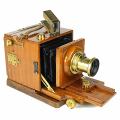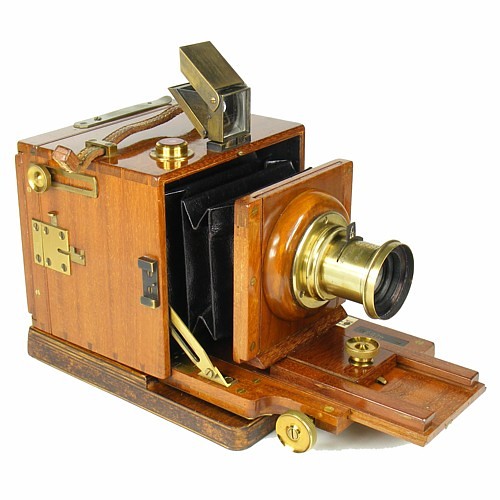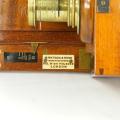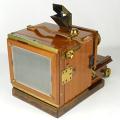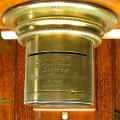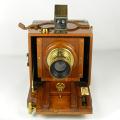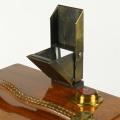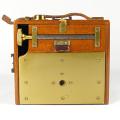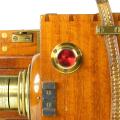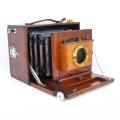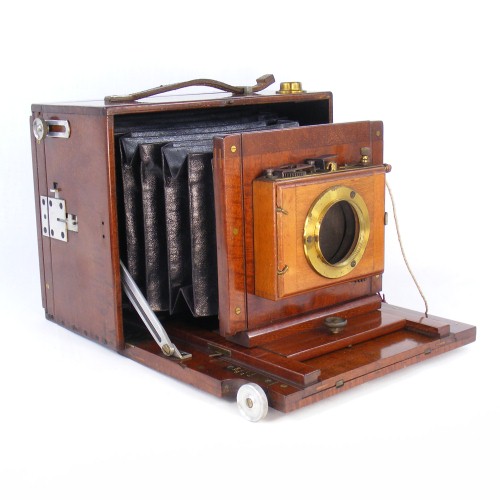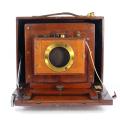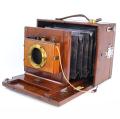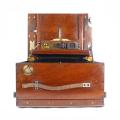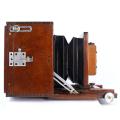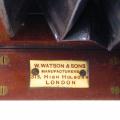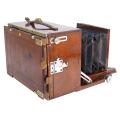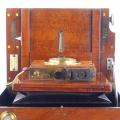Watson Alpha Camera
W. Watson & Sons
| Model / Variant: | No 2 |
| Plate / Film Size: | ¼ plate |
| Lens: | Perken Son & Rayment Rapid Rectilinear with separate waterhouse stops |
| Shutter: | None |
| Movements: | Rising & cross front, tilting back |
| Dimensions (w x h x l): | |
| Date of this Example: | c1895? |
| Serial Number: | Serial 10566 stamped into bottom edge of camera |
| Availability: |
|
| Inventory Number: | 268 |
|
Photos copyright © 2012 David Purcell. Do not use without permission. |
Description
The Watson Alpha is a beautiful box form hand or tripod camera. This ¼ plate version is very compact and of wonderful proportions as it folds up to a cubic form, without the need to remove the lens. The camera has a full range of movement (rise & cross front, tilting back, rack focussing adjustment). The Watson name plate is fitted to the lens board adjacent to the focus scale. The camera is complete with the separate optional finder (refer to the advert in the Photographic Advertising from A-Z), three dark slides and separate tripod board (very unlikely to be original to the camera as it is a different wood entirely).
This is a particularly fine example of the Watson Alpha camera. The No 2 designation and date is based upon the advert shown in Photographic Advertising from A-Z [8].
The outside face of the base board is faced with a brass plate. It is therefore tempting to believe that this might have been a tropical variant, but this is not likely; the tropical version of the camera were brass bound in a conventional manner to prevent the joints expanding. Compare with the Tropical Alpha in my collection.
It is difficult to date this particular camera with any precision as it was made over a long period with little variation. Refer to the notes below.
The camera was housed in a velvet lined pine box when I purchased it from a dealer. However I do not believe this box to be original - more likely dates to about 1930 or so, perhaps when the original leather case gave up?
There is also a tiny reducing bush with the camera, whose purpose is a mystery. Any ideas? (It is shown in front of the camera in the main picture)
~ # ~ # ~
| Model / Variant: | No 2 with aluminium fittings |
| Plate / Film Size: | ½ plate |
| Lens: | None |
| Shutter: | Unmarked Time & Instant roller blind shutter |
| Movements: | Rising front, tilting back |
| Dimensions (w x h x l): | 22 x 18 x 11 cm (closed) |
| Date of this Example: | c1897 |
| Serial Number: | Serial 10237 stamped into bottom edge of camera |
| Availability: |
|
| Inventory Number: | 610 |
|
Photos copyright © 2013 David Purcell. Do not use without permission. |
Description
This is an example of the much larger ½ plate version of the Watson Alpha camera, not dissimilar to the Tropical model, but with aluminium fittings. It has an early serial number of 10237. Adverts seem to offer aluminium fittings as an option for a number of years from about 1895, so the date of this camera is estimated on that basis.
The camera is made of good quality Spanish mahogany with very fine dovetail joints. However it is interesting to note that the dovetails seem to have been reinforced with screws in a number of places and in an irregular pattern, which may perhaps be a later repair? This sort of reinforcement does appear on dovetail joints on some cameras, but the random pattern and lack of alignment of the screw heads suggests that this might not have been done as part of the original manufacture.
The Watson name plate for "W. Watson & Sons" is fitted to the baseboard adjacent to the focus scale. The camera has double extension, square section bellows in a very dark maroon colour (appears black in dim light).
This is likely to be a relatively early example, judging by the format, notably the very simple structure of the lens board and side rails use to pull the camera out to focussing range. There are two focussing scales so presumably the camera was originally fitted with a convertible lens. Unfortunately the original lens has parted company with the camera.
The following fittings are of aluminium: side fittings for tilting back (including knurled nuts), handle fittings on top of camera and lens board, one of the two scale pointers (the other is brass), side stanchion, rails to hold DDS, focussing knob on pinion and the two locating blocks on the pinion. The assembly screws and other fittings are of brass.
There are a number of holes in the casing that presumably relate to fittings that have since been removed. There are a pair at the front edge of the top and sides that are likely to have been the fitting for a folding finder (as other Watson Alphas). A brass level is fixed on the top of the camera (dry).
There are tripod bushes to the underside of the lens board and one side of the camera, both showing signs of use. The camera came with a single 1/2 plate DDS, again with aluminium fittings (one side clamp broken). This fits the camera, is numbered 1 & 2 but is not serialised, so there is no guarantee it is original to the camera. The ground glass screen holder is present, but the glass is missing. This is sized at 7.5 x 5".
~ # ~ # ~
| Model / Variant: | Leather covered model |
| Plate / Film Size: | 5 x 4 plate (adapted to ¼ plate) |
| Lens: | Clermont & Gilmer Lightening Rectilinear |
| Shutter: | None |
| Movements: | Rising & cross front, tilting back. |
| Dimensions (w x h x l): | |
| Date of this Example: | c1894? |
| Serial Number: | None |
| Availability: |
|
| Inventory Number: | 498 |
<Photographs to be added>
Description
This Watson Alpha is a little more unusual as it is a leather covered version of the box form hand and stand camera, with bronzed metalwork (refer to Notes below for further information). It has a range of movements (rise & cross front, tilting back). The name plate shows 'W. Watson & Sons' and is fitted to the lens board adjacent to the focus scale. It has fittings for the separate optional finder on the top and one side face of the camera body.
The camera was originally designed for 5 x 4 plate format but has been adapted by a previous owner to ¼ plate by a reducing adapter (home made). It has double extension, square section bellows in a very dark maroon colour (appears black in dim light).
This Alpha is believed to be a relatively early example, judging by the format, notably the very simple structure of the lens board and side rails use to pull the camera out to focussing range and the fact it has a straight cut pinion on the focusing rack (change to a sprial pinion from about 1895).
The focussing scale has dual markings for 'SLIDES' and 'CHg BOX' (presumably Changing Box'). A previous user has added several additional scales, suggesting that it was used with a series of different lenses.
The Clermont & Gilmor lens carries no obvious serial number. The Lightning Rectilinear is not mentioned explicitly in the Lens Vade Mecum [10].
The top of the camera casing carries a retailers badge for 'The Westminster Photographic Exchange Ltd.'. According to Channing & Dunn [2], they became a limited company in 1907. The camera is of a much earlier date, so it is likely it was sold second hand by Westminster Photographic Exchange sometime after 1907, and badged by them at that time.
There appears to be a small section missing across the front of the focus slider as there are two empty screw holes, which are countersunk from the underside. It seems likely that originally there was a piece of mahogany across the front to prevent the slider coming right out of the rails.
Notes
I am engaged in some research into cameras made by W. Watson & Sons in order to try and establish some guidance on likely manufacturing date based upon the serial number. This is in fact quite difficult to do currently as many patterns of Watson cameras were made for very long periods with few significant design changes.
If you have a Watson camera, then I would be grateful if you could provide me with further information about your camera, even if it is not serialised. Please refer to the Watson Research Project page for further information.

![[ ]](../../images/unchecked.png)
![[x]](../../images/checked.png)
